|
Introducing
Pakistan
The
Islamic Republic of Pakistan came into being as
an independent state on 14 August, 1947. Located
in South Asia, Pakistan shares an eastern border
with India and a northeastern border with China.
Iran makes up the countryís southwest border,
and Afghanistan runs along its western and
northern edge. The Arabian Sea is Pakistanís
southern boundary with 1,064 km of coastline. The
country has a total area of 803,940 sq km with a
land area of 778,720 sq km and is nearly four
times the size of the United Kingdom. From
Gwadar Bay in itís south-eastern corner, the
country extends more than 1,800 km to the
Khunjerab Pass on Chinaís border.
|
The
impact of Islam since the 10th Century
A.D. was the deepest and the most
far-reaching, bestowing a new way of
life based on equality, justice and
peace, transforming the land and the
people.
Urdu is the country's national language
while English is extensively used in
offices and commercial circles. Other
regional languages include Punjabi,
Pashto, Sindhi and Balochi.
|
|
| |
Mughal
Architecture - Lahore
|
Pakistan comprises four
provinces - Punjab, Sindh, North West Frontier
and Balochistan - and the Federally
Administrated Tribal Area. The country presents
a variety of landscapes . The north to
northwestern mountainous belt is largely a
barren region that features many of the world 's
tallest peaks.
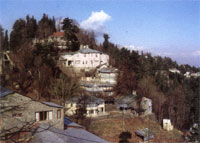 |
The land beneath the
lofty peaks of Himalayas, Karakoram and
the Hindukush, However, is a fertile
land with beautiful tree-clad slopes and
valleys, trumb-ling streams well-stocked
with fish and forests abounding with
small and big game.
|
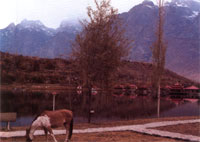 |
|
A
beautiful Hill Resort, near Islamabad
|
|
Honeymoon
Lake - Skardu
|
Climatically, Pakistan is
mainly dry with rainfall varying between four to
forty inches a year. Temperature varies from
extreme summer heat in some places, to a brisk,
invigorating cold in winter with heavy snowfall
at elevations.
Islamabad,
with an area of 906.5 kms, is the capital of
Pakistan and is situated at the foot of Murree
Hills, forms the northeast part of the Potwars
Plateau. Islamabad enjoys a pleasant climate.
The maximum average
in winter is 16.7 0C, and minimum 3.4
0C; in summer it is 34.2 0C,
and 24.4 0C.
The Aiwan-e-Sadr (Presidency), Parliament
Building, Secretariat Blocks, State Bank
Complex, Rawal Lake and Faisal Mosque are some
of the Capital's land marks.
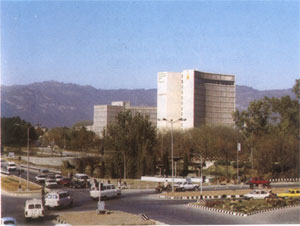
Main Entrance to Capital - Islamabad
Pakistan
embarked upon a modest programme to make a major
breakthrough in various fields of
communications. It is going ahead with its plans
and programmes of modernisation and advancement
in this essential sector. Thousands of
kilometers of new highways and roads are being
constructed to cover most parts of the country.
Telecommunication networks are being improved
and expanded to facilitate round-the-clock
service. A new and most modern airport has
already been built at Karachi, while more are
being designed. New methods and policies are
being adopted to improve public transport
facilities.
For
improving the railway system, private sector has
been involved in selling tickets and checking on
some of its sections. A programme is being
undertaken for modernizing the existing seaport
and building an additional deep-water port. In
the air transport sector, 13 private parties
have been approved to operate airlines.
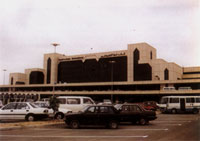 |
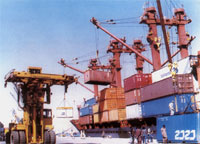 |
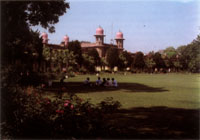 |
|
Karachi
International Airport
|
Container
Service at Karachi Port
|
Agriculture
University- Faisalabad
|
The
present literacy rate is estimated at 35 percent
which shows substantial improvement over 26.2
percent in 1981. The population of Pakistan
nearly doubled over a half-century period. The
current growth rate of 3.0 percent is the
highest among the nine most populous countries.
Pakistan's
conventional energy resources are inadequate to
meet generating its ever-increasing power needs.
The country is largely dependent on
hydro-electricity for which the installed
capacity at present is 10598 MW. However, the
low river flows in winter cause a substantial
decline in the generating capacity of the
hydro-electric plants. The country has to look
for other sources of energy such as gas, oil and
nuclear energy.
|
|
|
|
National
Oil Refinery- Karachi
|
D.G.Khan
Cement Factory
|
|
|
|
Pakistan
Steel Mill - Karachi
|
|


